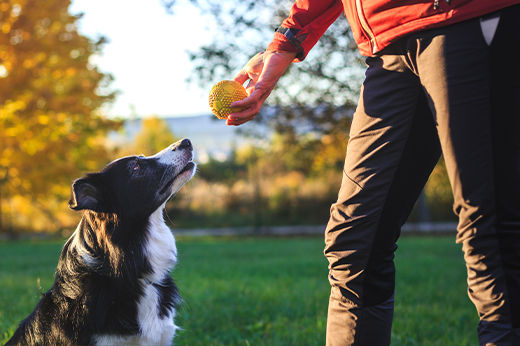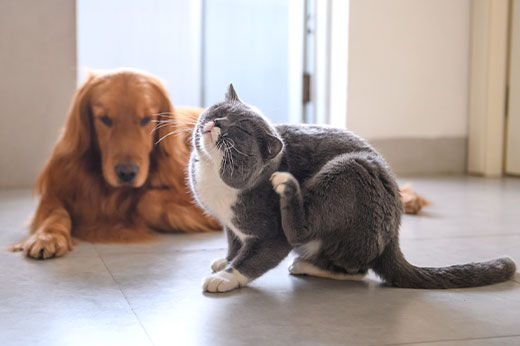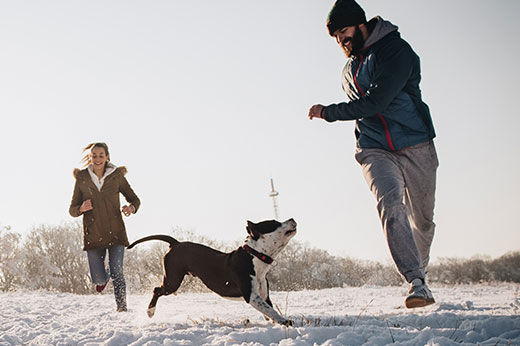While do-it-yourself projects can be fun and fulfilling, there is always a potential for personal injury or property damage. We strongly suggest that any project beyond your abilities be left to licensed professionals such as electricians, plumbers, and carpenters. Any action you take upon the information on this website is strictly at your own risk, and we assume no responsibility or liability for the contents of this article.
How to Install a Pet Door
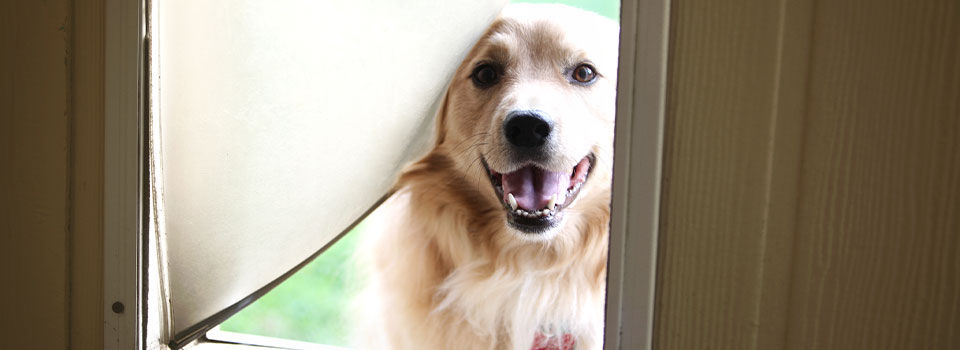
Would you like to give your dog or cat the freedom to go out in the yard as they please? Many pet owners are happy to have their pets let themselves in and out the door (to a fenced yard) whenever they need to get fresh air, potty, or play.
Fortunately, it’s easy to install a pet door by yourself. This simple DIY project requires a few basic tools and skills, but it’s well worth the effort. Provide your pet with happiness and enrichment by allowing them access to playtime in the great outdoors with a DIY pet door installation.
Should You Install a Dog Door in Your Home?
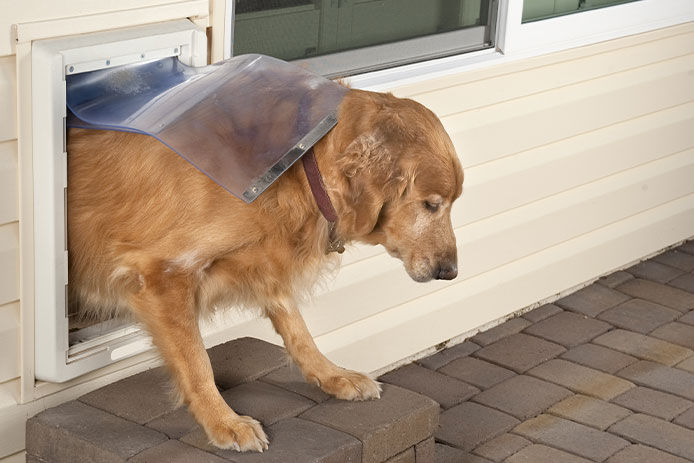
Pets, particularly dogs, need to potty outdoors. Smaller dogs and older dogs may need to potty frequently, and a pet door can give them the independence to go out and take care of business on their own.
A pet door can be a great idea if you have a safe, fenced-in yard. It can even increase the safety and security of your home. Most intruders are deterred when a dog runs out of the dog door. Similarly, it can give your dog stimulation and an outlet, especially if they are a higher-energy pup.
As for cats, a pet door can also allow them to explore outside. If you have a screen porch or a cat enclosure, it's helpful for cats to have a safe, simple entryway with a cat flap. Generally, it's not a great choice to allow cats to freely explore on their own. Many cats can easily get over fences and barriers, presenting safety hazards to themselves and neighborhood birds and wildlife. There are window pet doors that can work well for cats—with a small opening that gives them easy access to a screened porch or play area.
With canine friends, keeping dogs safe with a doggy door means training them when and how to use the door properly. Look for a large dog door that locks when not in use or works with a storm door. Dogs shouldn’t be left outside for long periods without supervision, at night, or when no one is at home. For your peace of mind, it's best to have a pet door that is secure and safe.
But with the right planning and a safe, secure pet door, you can give your pets more confidence and enrichment. Your pets will love taking themselves outside to exercise, play, and potty. Pet doors are especially ideal for homeowners with large, fenced-in yards.
How Much Does Pet Door Installation Cost?
Pet doors are usually quite affordable, ranging from about $35 to $150 for the door itself. The price of the door depends on the materials, size, and features (like locking mechanisms).
You can save quite a bit by taking the DIY approach and learning how to install a dog door on your own. While many door installation companies will offer pet door options, the labor and other associated costs can make it a prohibitive project.
For most homeowners, a simple pet door installation is an easy project that can be fun for you and your furry friend!
Steps to Installing a Pet Door
Before you begin to install a pet door, you’re going to need to make a few decisions. A simple flap-design pet door is the best solution for many homeowners, but you'll need to ensure you can lock the door at night.
Tools & Materials Needed
Ready to install a pet door? As with most DIY projects, having the right tools for the installation is essential. You'll need the following tools:
Once you've gathered your supplies, the following steps will help you install new doggy doors in your home. Follow the installation instructions in the kit for the best results. If you need additional information on installing your doors, there will usually be a manufacturer contact number you can call with questions. It's a good idea to lay out all the supplies and tools before you begin.
Step 1: Decide Where to Install the Dog Door
Decide on the door that you plan to use. Some doggie doors work well with sliding glass doors or French doors. When you aren't using the doggie door, you can remove it and secure the sliding door. Other dog and cat doors require alterations to your exterior door or entry screen door. Before you install a pet door, it’s important to decide on the right location (one that leads to a fenced area or enclosure) and to be sure you have a compatible entry door.
There are many different doors available. If you have small dogs, you can go with almost any size. A larger dog, like a Great Dane, will require planning to ensure you have the right pet door for your best friend. The best location is often your main door or the door to your backyard.
Step 2: Choosing the Right Sized Dog Door
Once you've decided on a location, you'll also need to know the right size and dimensions. That means grab your fur baby and measure them! Typically, doors will indicate the height and width to help you choose the best size for your pet. Ideally, the door should be two inches wider and two inches taller than your pet's shoulders. You want your pet to feel comfortable when they use the door. Be sure to consider the size of the pet door opening for your pet—not the size of the hardware itself.
You'll also want to consider a door-mounted dog door or a wall-mounted dog door. A wall-mount door requires quite a bit of additional planning and work. For example, for a wall-mounted door, you'll need to consider removing the exterior finish and creating a tight seal, working around insulation, and not disrupting any wiring or load-bearing elements when you put the pet door on exterior walls. For a first-time installer, we recommend going with a door-mounted flap pet door for best results. Door-mounted pet doors are a great option for almost any type of door.
Step 3: Mark the Placement of the Door
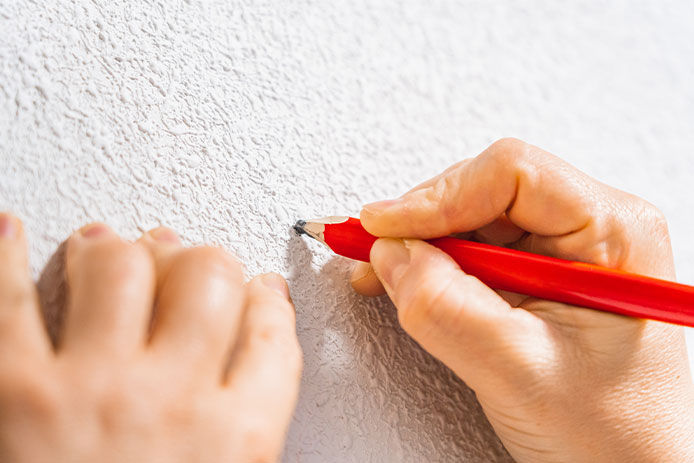
Now you've decided on the spot for your new pet door, it's time to get to work on the installation. Most pet doors come with a template, making it easy to size the spot for the new pet door properly. You can trace the template with a pencil, marking where you should put the screw holes as well. You will also need to mark the inside corners of the opening.
Position the door so that your pet can easily get in and out. It should run along the bottom of the door, often along the opening edge. The pet door should sit along the outer frame when the door closes.
Step 4: Drill and Create the Hole for the Pet Door

Using an electric drill and ½ inch drill bit, create screw holes at the center point of each marking to mount the hardware. Follow the instructions from the manufacturer to ensure you take the right steps to install your particular door.
Next, you’ll use a handsaw to cut the opening along the pencil lines for the pet door. It may be easier to remove the entry door from the hinges and put it over a drop cloth so you can easily see the hole. Start in one corner and slowly look around the outline. Keep your cuts as close to the pencil line as possible for best results.
Step 5: Install Your New Pet Door
Once you’ve cut the opening for your pet door, you’ll insert the interior and exterior frames that hold the flap opening of the pet door. Start with the exterior frame (the side with no flap), inserting it into the exterior side of the door. The side should sit flush against the door’s surface. Most pet doors come with mounting hardware. Using the supplied screws from your pet door kit, hold the exterior frame in place, and drill in the screws where you marked the holes.
Next, take the interior frame (with the flap) and insert it on the inside of the door. Follow the pencil marks and drill the screws into place to securely attach the frame's interior to the inside. Use a level to ensure the frame is straight, then finish tightening the screws.
Step 6: Test Your Pet Door and Let Your Furry Friend Enjoy It!

Your pet door is installed! It’s a nice idea to go around the pet door frame with some caulk to seal the frame and keep any outside air from leaking inside. Test the locking mechanism to ensure that it works properly and securely. The best dog doors are the ones that you can rely on to keep your pet safe.
The only thing left to do is to let your dog or cat test out the pet door. Sometimes, it can take some time for them to warm up to the idea of using the door. Try some treats and lots of praise to incentivize them to come in and out of the door. After a few tries, they'll get the hang of it and will likely enjoy their newfound freedom!
Installing a pet door is a simple DIY project that’s great for any homeowner who wants to maximize their pet’s happiness and independence. It can make it much easier on you, especially if you have an outdoor-loving pet that wants to come and go frequently.
If you’re looking for supplies to install a pet door in your house, look no further than your local Do It Best. We have everything you need for all your home improvement projects!

